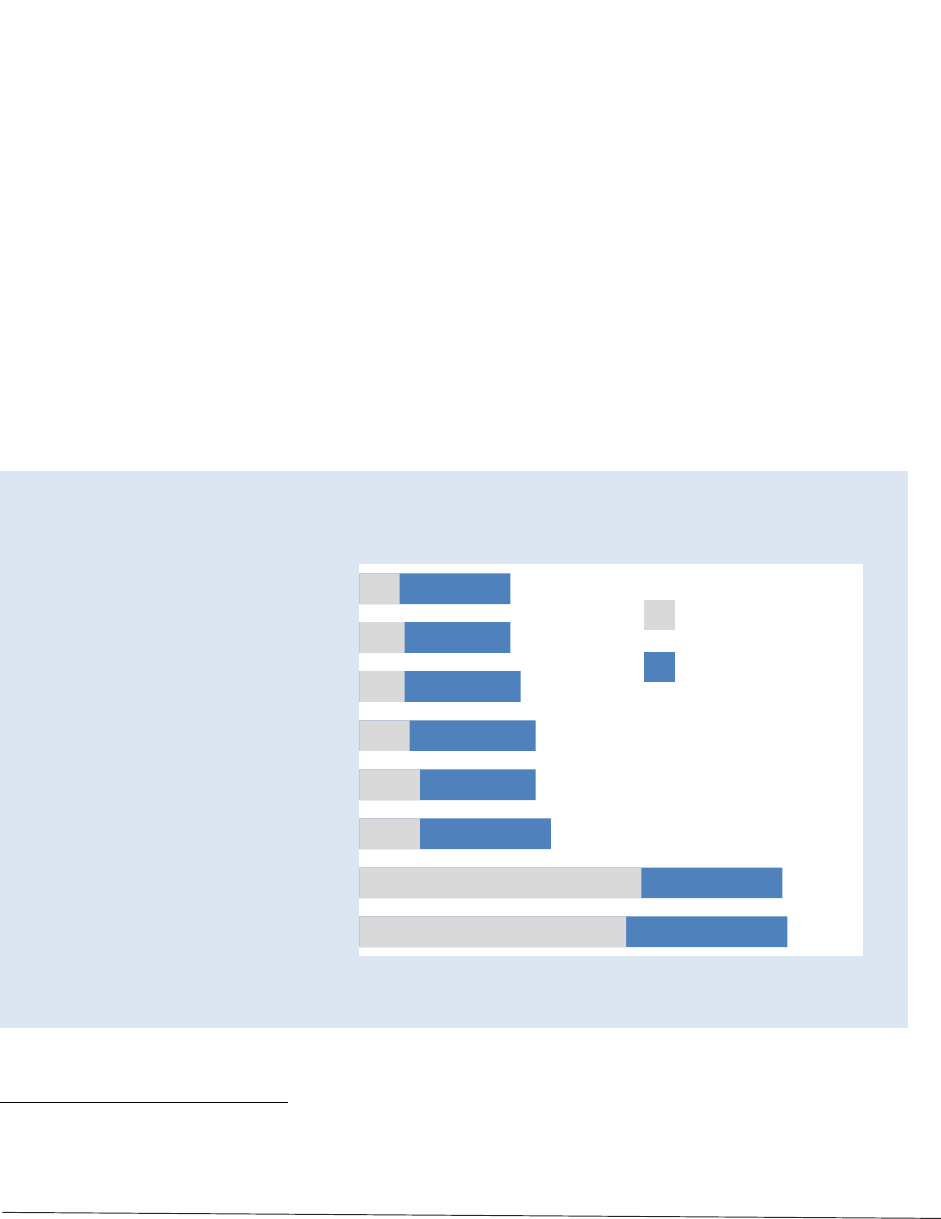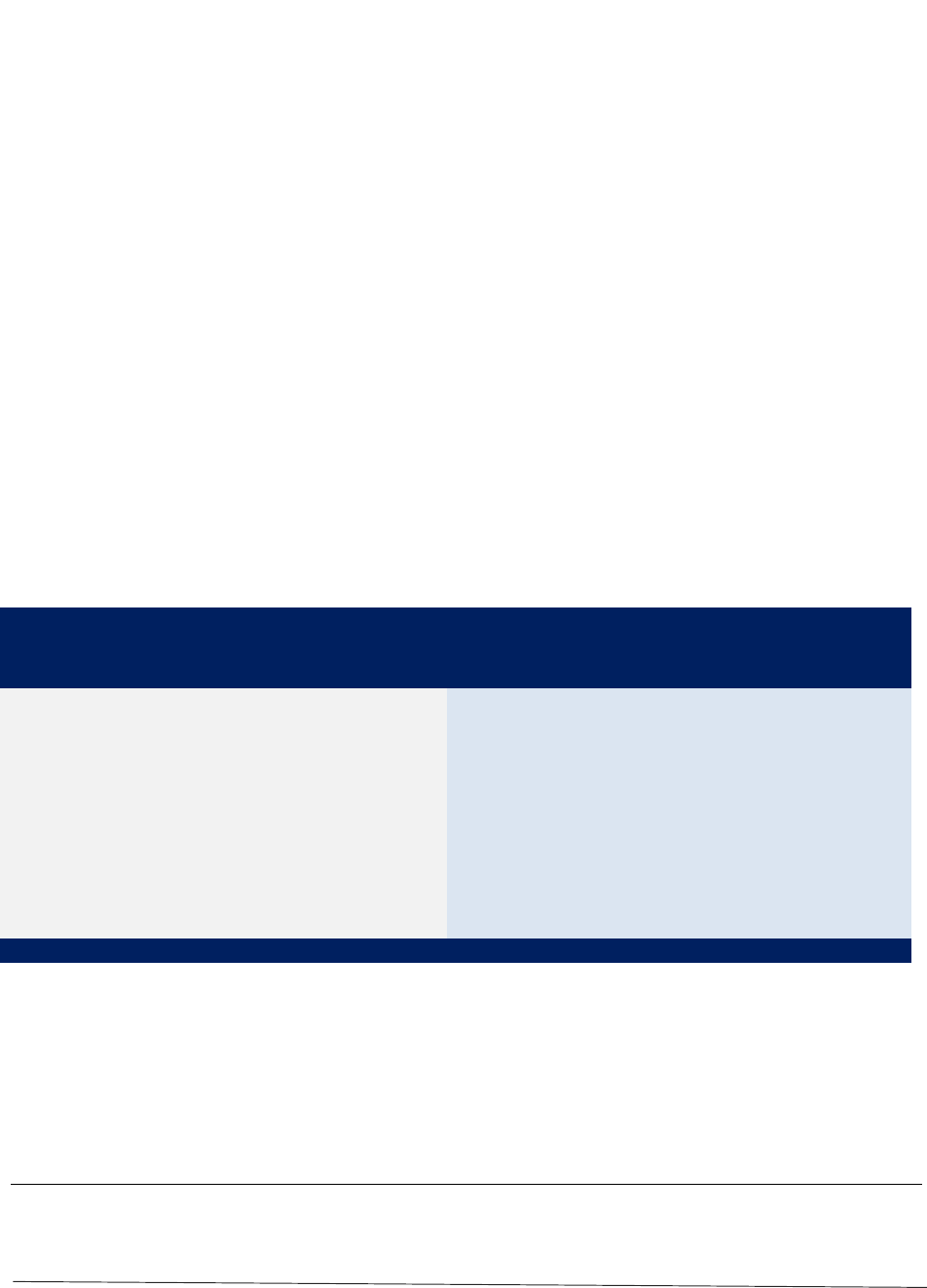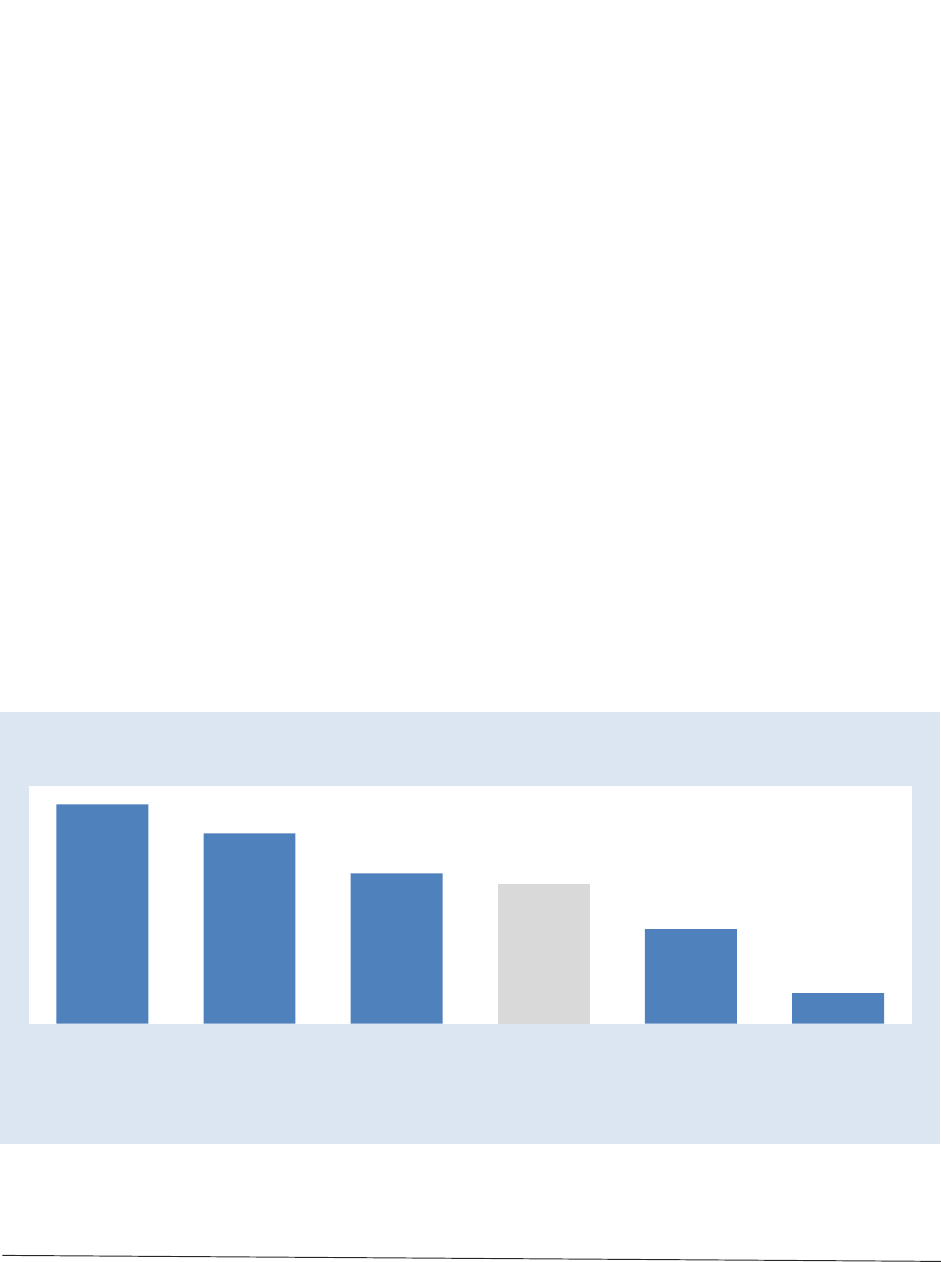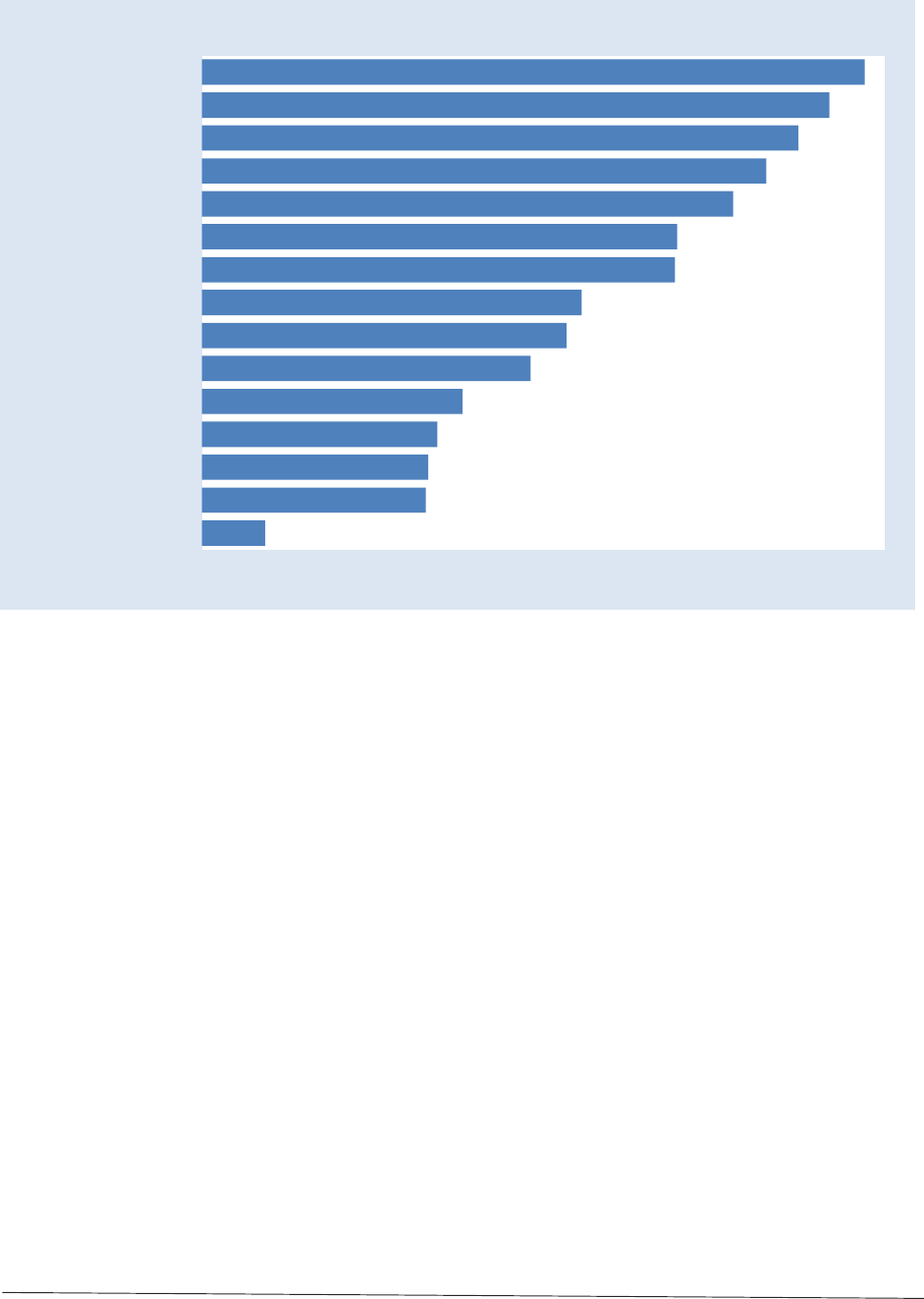
Major Auto Insurers Raise Rates Based on
Economic Factors
Low- and Moderate-Income Drivers Charged Higher Premiums
June 2016
Douglas Heller
Michelle Styczynski

Major Auto Insurers Raise Rates Based on Economic Factors
Consumer Federation of America | Page 2
Introduction
All states except New Hampshire require drivers to purchase auto insurance, and the importance of
automobile ownership for most Americans adds a special responsibility to ensure fairness in the
auto insurance marketplace.
1
In most states, however, auto insurance premiums are driven in large
measure by economic factors that are unrelated to driving safety, a practice that most Americans
consider unfair. Among the most common of the individual economic and socio-economic
characteristics used by auto insurers are motorists' level of education, occupation, homeownership
status, prior purchase of insurance, and marital status. Because each of these factors are associated
with an individual's economic status and because insurers consistently use each factor to push
premiums up for drivers of lesser economic means, the combined effect of insurers' use of these
factors can result in considerably higher prices for low- and moderate-income Americans, leaving
many overburdened by unfairly high premiums and others unable to afford insurance at all.
For this study, Consumer Federation of America (CFA) tested premium quotes for men and women
in 15 cities across the country offered by the nation's five largest automobile insurers. Using a
methodology for distinguishing good drivers of lower and higher economic status, CFA was able to
determine how much more basic, liability-only auto insurance costs on average for drivers as a
result of these five non-driving related factors.
2
This study sheds new light on the cumulative
impact of auto insurance companies' pricing techniques and makes recommendations for
policymakers and regulators concerned about ensuring access to affordable auto insurance and
reducing the number of uninsured drivers.
In conjunction with this research, CFA also surveyed a representative sample of Americans
regarding the fairness of using various factors in the pricing of auto insurance. The results of this
survey offer new insights into the perspectives of consumers about insurance companies' use of
both driving related factors and non-driving related factors.
1
The requirement that drivers in every state but New Hampshire purchase auto insurance is compounded as an issue of social
concern because of the strong relationship between access to a car and employment rates, hours worked, and earnings. See, for
example: Charles L. Baum, “The Effects of Vehicle Ownership on Employment,” Journal of Urban Economics,” v. 66, n. 2,
151-163. Evelyn Blumenberg and Margy Waller, “The Long Journey to Work: A Federal Transportation Policy for Working
Families,” Center on Urban and Metropolitan Policy, Brookings Institute (July 20003).
2
There are other factors that drive up auto prices not analyzed here, the most important of which is credit-based scores. Another
rating factor that can impact rates and is related to economic status, the ZIP code in which the customer lives, was not measured
in this study, as all the drivers from each city were tested using the same address.

Major Auto Insurers Raise Rates Based on Economic Factors
Consumer Federation of America | Page 3
Summary of Findings
CFA has found that good drivers of lower economic status consistently pay significantly more for
auto insurance than higher economic status drivers. Four of five of the nation's largest auto
insurers regularly charge 40 percent to 92 percent more, or about $600 to $900 more per year, to
drivers based on factors related to their economic status even when they have perfect driving
records.
Among the findings:
A substantial majority of Americans believe it is unfair for insurance companies to use
economic characteristics – specifically, education level, occupation, not having insurance
because of not having a car, homeownership status, marital status, and credit score – in setting
auto insurance premiums.
Good drivers pay 59 percent more, or $681 annually, on average for auto insurance due to
personal characteristics associated with lower economic status.
GEICO and Progressive charge the largest average percentage increases (92 percent and 80
percent, respectively) to lower economic status drivers.
Allstate and Farmers charge the largest average annual dollar increases ($915 and $900,
respectively) to lower economic status drivers.
State Farm charges smaller increases to lower economic status drivers (13 percent, or $217
annually).
3
Drivers in Queens, Jersey City, Boston, Atlanta, Minneapolis, Houston, and Jacksonville face
some of the steepest increases, all of which average more than $700 more per year for good
drivers due to their economic status.
3
As is discussed, other research has shown that State Farm relies heavily on the use of credit scores, which can substantially raise
premiums on lower-income drivers.

Major Auto Insurers Raise Rates Based on Economic Factors
Consumer Federation of America | Page 4
Consumers believe auto insurance should be based on driving safety
factors and not economic characteristics
In June 2016, CFA commissioned ORC International to conduct a representative survey of 1,000
Americans to ascertain the public's view of the use of various rating factors in the setting of auto
insurance premiums. The survey found that 83 percent of the public found it very fair or somewhat
fair for auto insurers to use traffic accidents caused in setting premiums and 84 percent found it
very or somewhat fair to use moving violations such as speeding tickets. The near opposite was
true for the non-driving related factors that reflect drivers' economic status, as shown in Figure 2.
4
Respondents were asked the following question for each of the eight rating factors tested:
As you probably know, auto insurers use many factors to decide how much each driver is
charged for their insurance coverage. How fair do you think it is for insurers to use each of the
following factors in deciding on an auto insurance price for a driver? Would you say each is
very fair, somewhat fair, somewhat unfair or very unfair?
For the survey, the order in which the different factors were presented was randomized.
4
The survey of 1,006 Americans had a margin of error of +/- 3.09 percent at the 95 percent confidence level.
53%
56%
12%
12%
10%
9%
9%
8%
Moving violations
Traffic accidents caused
Credit scores
Homeownership
Occupation
Marital status
No previous insurance because no car
Level of education
Figure 1. Percentage of Americans who find each rating factor very fair or
somewhat fair
Source: ORC International Survey conducted June 9-12, 2016, all figures are rounded
21%
23%
25%
23%
26%
28%
32%
Somewhat fair
Very fair
22%

Major Auto Insurers Raise Rates Based on Economic Factors
Consumer Federation of America | Page 5
Only about one in 10 Americans think the use of these non-driving factors is "very fair." Conversely,
over six in ten Americans consider it somewhat or very unfair to use the non-driving factors
associated with economic status.
Data and Methodology
Prior Research
In previous reports, CFA collected premium quotes from individual companies' websites to assess
the impact of various rating factors on the price of auto insurance. Using this method, previous
research found, for example, that several major insurers charge significantly higher premiums to
drivers with only a high school diploma than to those drivers with higher levels of education, such
as a master’s degree.
5
Previous research also found that in many states, some major insurers
provide no discount, or only a minimal discount, to low-mileage drivers, despite the actuarial
evidence that annual mileage strongly correlates with risk of loss.
6
In 2014, CFA used a comprehensive dataset of auto insurance quotes for a typical moderate-income
good driver acquired from Quadrant Information Services to evaluate the availability and
accessibility of state-mandated auto insurance in lower-income communities in the 50 largest
metro areas. The report found that in approximately a third of lower-income ZIP codes none of the
largest insurers offered a basic policy for less than $500.
7
A later analysis of this data, published by
CFA in 2015, found that in communities where more than three quarters of the residents are
African American, auto insurance premiums average 70 percent higher than in those with
populations that are less than one quarter African American.
8
An analysis of similar Quadrant
Information Services data found that good drivers with low credit scores are charged as much as
127 percent more than drivers with high credit scores, controlling for all other factors including
driving record.
9
,
10
5
Brobeck, Stephen. “Use of Education, Occupation, and Other Non-Driving Factors Inflate Premiums for Low- and Moderate-
Income Drivers.” Washington, DC: Consumer Federation of America, September 24, 2012.
http://consumerfed.org/pdfs/PR.AutoInsuranceRateFactorRelease.9.24.12.pdf
6
Brobeck, Stephen, and Michelle Styczynski. “Auto Insurers Fail to Reward Low Mileage Drivers.” Washington, DC: Consumer
Federation of America May 21, 2015. http://consumerfed.org/news/902
7
Feltner, Tom, Stephen Brobeck, and J. Robert Hunter. “The High Price of Mandatory Auto Insurance for Lower Income
Households: Premium Price Data for 50 Urban Regions.” Washington, DC: Consumer Federation of America, September 2014.
http://consumerfed.org/pdfs/140929_highpriceofmandatoryautoinsurance_cfa.pdf.
8
Consumer Federation of America. "High Price of Mandatory Auto Insurance in Predominantly African American
Communities." November 2015.
9
Brobeck, Stephen, J. Robert Hunter, and Tom Feltner. “The Use of Credit Scores by Auto Insurers: Adverse Impacts on Low-
and Moderate-Income Drivers.” Consumer Federation of America, December 2013.
http://www.consumerfed.org/pdfs/useofcreditscoresbyautoinsurers_dec2013_cfa.pdf
10
Besides the studies discussed briefly above, CFA previously studied several rating factors individually and did other research
on the plight of low- and moderate-income affording state-required auto insurance. A list of all precious studies with thumbnail

Major Auto Insurers Raise Rates Based on Economic Factors
Consumer Federation of America | Page 6
Each of these studies laid the groundwork for the critical question we sought to answer in this
report: What is the cumulative impact of having socio-economic characteristics associated with low-
and moderate-income on the premiums paid by good drivers?
About the insurance premiums used in this report
For this report, CFA used the websites of the five largest auto insurers in the nation to determine
the premium that would be offered to four different drivers (two men and two women with
different socio-economic characteristics) in 15 cities across the country. The four drivers tested are
described in Figure 2.
In each case, the quotes are only for the minimum mandatory liability insurance that a driver is
required to carry in each state, except where a company did not offer state minimum limits
coverage through its website, as noted in the Appendix. CFA tested 300 drivers for this study and
received 259 online premium quotes; there were 20 tests where a company did not appear to
operate in a state and 21 instances where an insurer would not provide an online quote for lower
economic status drivers. All premiums were quoted for six-month policy terms and have been
annualized for this report.
Figure 2. About the driver profiles used in this study
All Drivers: 30 years old and licensed for 14 years; no accidents; no violations; drives a 2006 Toyota Camry
10,000 miles each year; all drivers have the same address for each city tested.
Female – High Economic Status: Bank executive
with a master's degree, is a homeowner, has had auto
insurance coverage with the same company for three
years, and is married.
Male – High Economic Status: Manufacturing
executive with a master's degree, is a homeowner, has
had auto insurance coverage with the same company for
three years, and is married.
Female – Low Economic Status: Bank teller with a
high school degree, is a renter, has not had auto
insurance for six months because she has not had a
car, and is single.
Male – Low Economic Status: Factory worker with a
high school degree, is a renter, has not had auto
insurance for six months because he has not had a car,
and is single.
descriptions can be found at http://consumerfed.org/cfa-studies-on-the-plight-of-low-and-moderate-income-good-drivers-in-
affording-state-required-auto-insurance

Major Auto Insurers Raise Rates Based on Economic Factors
Consumer Federation of America | Page 7
When shopping for auto insurance most consumers find that insurance companies request a range
of personal information that is unrelated to their driving history or car they wish to insure. It is
unlikely, however, that many of these shoppers are aware of the extent to which their answers to
these questions impact the price they will pay for auto insurance. There are five common questions
asked by auto insurers that are not driving-related and tend to be good indicators of a customer's
economic status:
1. Are you married? Unmarried people have lower incomes than married people.
2. What is your occupation? Blue collar and hourly workers have lower incomes than white collar
and salaried workers.
3. What is your highest level of education? Lower levels of education are associated with lower
income.
4. Do you currently have auto insurance? Whether because a driver did not have a car for a period
of time or because their coverage lapsed, drivers without current insurance tend to have lower
incomes. (In the data collected as part of this study, the lower economic status drivers did not
have a car for the past 6 months).
5. Do you own or rent your home? The median income of renters is less than half that of
homeowners.
As is discussed below, this report shows that, with almost no variation, the price charged to
consumers is inversely related to the economic indication associated with their answers to these
five questions. In this report, CFA has calculated the cumulative impact of these non-driving related
factors for basic liability-only policies that drivers in all states except New Hampshire are required
to purchase.
Another typical question – what is your social security number? – provides insurers with the
information they need to incorporate drivers' credit scores into premiums, with the same inverse
relationship in which premiums go up as credit scores (another indicator of economic status) go
down. Though this factor was not tested in this study, a 2015 Consumer Reports study found that
premiums rose significantly for drivers with low credit scores.
11
Inclusion of credit scores would
further increase the disparities found in this report in every city except Boston and Los Angeles
where auto insurance credit scoring is prohibited.
11
http://www.consumerreports.org/cro/car-insurance/credit-scores-affect-auto-insurance-rates/index.htm CFA also found similar
results in a 2013 study: Brobeck, Stephen, J. Robert Hunter, and Tom Feltner. “The Use of Credit Scores by Auto Insurers:
Adverse Impacts on Low- and Moderate-Income Drivers.” Washington, DC: Consumer Federation of America, December 2013.
http://www.consumerfed.org/pdfs/useofcreditscoresbyautoinsurers_dec2013_cfa.pdf

Major Auto Insurers Raise Rates Based on Economic Factors
Consumer Federation of America | Page 8
Analysis and Findings
On average, a high economic status driver is charged $1,144 per year for a minimum limits policy
offered by the five companies tested in 15 cities. A low economic status driver with the same
driving record and living at the same address is charged a premium of $1,825 on average for the
same coverage. That difference, $681 per year, amounts to a 59 percent penalty that insurers
impose on good drivers based solely on their answers to the five economic status questions
described above.
Where companies provided quotes for both the higher and lower economic status driver, the driver
with the lower economic status characteristics faced a premium increase 92 percent of the time.
Those drivers were charged at least 25 percent more two-thirds of the time, and a fifth of the lower
economic status drivers paid at least double that of his or her higher status counterpart, despite
having the same driving record, driving the same car, being the same age, having driven for the
same number of years and living at the same address. There were only three instances (about 1
percent) in which the lower economic status driver paid less than the higher economic status
driver.
On a nationwide basis, GEICO imposed the largest average premium hikes by percentage on good
drivers with lower socio-economic indicators (92 percent increase), and State Farm increased rates
the least based on the factors tested (13 percent), as shown in Figure 3. We note, however, that
according to the 2013 CFA report on credit scoring in auto insurance cited above, State Farm used
credit scoring to raise rates on drivers with the lowest credit scores by 127 percent on average over
those with the best credit scores. That impact cannot be captured through the website testing
methodology used for this report since it would require the use of a Social Security number.
92%
80%
63%
59%
40%
13%
GEICO Progressive Farmers Average of all
quotes
Allstate State Farm
Source: CFA premium testing, see Appendix
Note 1: Excludes city data where company does not provide quote to lower economic status driver
Figure 3. 15 city average increase for lower economic status drivers by company

Major Auto Insurers Raise Rates Based on Economic Factors
Consumer Federation of America | Page 9
As noted above, the lower economic status driver in the cities tested pays $681 more per year on
average for a basic auto insurance policy than drivers with the same good driving record but with a
higher economic status. While GEICO and Progressive show the largest economic status penalties
as a percentage of premium, the dollar impact, shown in Figure 4, is the largest for customers of
Farmers and Allstate, which charged substantially higher premiums overall than the other three
companies tested.
The wide variation in premiums among companies noted above, while not the central focus of this
report, is notable. As a review of the Appendix reveals, the price offered to the same driver buying
the same coverage in the same city can vary dramatically from company to company. For example,
in Minneapolis, State Farm charges a low economic status male driver $994 per year for a minimum
limits policy, while Farmers charges the same driver $3,626 per year. Similarly, in Baltimore a low
economic status female driver is quoted a premium of $1,232 by GEICO, but the exact same driver
faces a $2,544 premium from Progressive.
$915
$900
$830
$681
$614
$217
Allstate Farmers Progressive Average of all
quotes
GEICO State Farm
Figure 4. 15 city average annual increase in dollars for lower economic status drivers,
by company
Source: CFA premium testing, see Appendix
Note 1: Excludes city data where the company did not provide a quote to the lower economic status driver
Note 2: Allstate's Jersey City and Boston quotes are for coverages higher than the basic limits policy mandated by
state laws, because the company did not quote minimum limits-only policies online in those cities.

Major Auto Insurers Raise Rates Based on Economic Factors
Consumer Federation of America | Page 10
Drivers in all cities but Los Angeles pay at least 33 percent more on average due to
non-driving related, economic status factors; some pay much more
Drivers face steep rate hikes in every city tested due to economic status factors, with the exception
of Los Angeles as is discussed below. The largest increase on a percentage basis was the 309
percent premium hike for a female driver in Minneapolis handed out by GEICO. While the
companies varied in the degree to which they punished good drivers based on economic status
indicators, there were at least two instances for each company in which the economic status
penalty exceeded $1,000 per year. Figure 5 shows the two largest rate hikes in the cities tested for
customers of each company.
Figure 5. Largest increases by company
Company
City
High Status
Premium
Low Status
Premium
Increase
Percent
$
Allstate*
Jersey City, NJ (Female)
Jersey City, NJ (Male)
$3,138
3,150
$8,906
8,358
184%
165
$5,768
5,208
Farmers
Houston, TX (M)
Houston, TX (F)
1,380
1,408
3,390
3,218
146
129
2,010
1,819
GEICO
Minneapolis, MN (F)
Minneapolis, MN (M)
528
528
2,158
1,840
309
248
1,630
1,312
Progressive
Queens, NY (F)
Atlanta, GA (F)
2,174
764
6,668
2,000
207
162
4,494
1,236
State Farm
Queens, NY (M)
Queens, NY (F)
2,438
$2,388
4,144
$3,974
70
66%
1,706
$1,586
Source: CFA premium testing, see Appendix
*Note: Allstate does not offer a New Jersey minimum limits policy through its website; NJ Allstate quotes are for the lowest liability
coverage (50/100) available online
As can be seen in Figure 6, the lower economic status driver pays substantially more on average (at
least $200) for basic auto insurance in every city except Los Angeles. Drivers in Atlanta, Baltimore,
Boston, Houston, Jacksonville, Kansas City, and Minneapolis pay more than $500 per year extra for
having the characteristics of lower economic status. In the highest cost cities of Jersey City and
Queens
12
, lower economic status drivers pay an average $1,815 and $1,856 more, respectively,
despite their good driving record.
12
The tests for Queens, NY, were for a driver living in the Far Rockaway neighborhood.

Major Auto Insurers Raise Rates Based on Economic Factors
Consumer Federation of America | Page 11
Figure 6. Average premium for good drivers with different economic status characteristics, by city
High Status
Low Status
Difference ($)
Change (%)
Queens, New York
$1,912
$3,769
$1,856
97%
Atlanta, Georgia
938
1,800
862
92
Kansas City, Missouri
662
1,241
579
87
Jacksonville, Florida
908
1,659
751
83
Jersey City, New Jersey
2,333
4,148
1,815
78
Boston, Massachusetts
1,062
1,801
739
70
Houston, Texas
1,063
1,800
737
69
Minneapolis, Minnesota
1,539
2,394
856
56
Seattle, Washington
854
1,309
456
53
Phoenix, Arizona
853
1,264
411
48
Baltimore, Maryland
1,644
2,272
628
38
Oklahoma City, Oklahoma
859
1,155
296
34
Pittsburgh, Pennsylvania
724
963
240
33
Chicago, Illinois
697
925
228
33
Los Angeles, California
$859
$939
$80
9%
Average of all quotes
$1,144
$1,825
$681
59%
Source: CFA premium testing, see Appendix
Note 1: Excludes city data where company does not provide quote to lower economic status driver
The only instances where premiums came down for drivers were from Allstate, which lowered
rates by 19 percent for the lower economic status female driver in Chicago and by 4 percent for
both male and female drivers in Oklahoma City. These represent about 1 percent of all quotes
offered by the companies tested in the fifteen cities.
The average percentage increase paid by lower economic status drivers in each city is shown in
Figure 7.

Major Auto Insurers Raise Rates Based on Economic Factors
Consumer Federation of America | Page 12
As can be seen in the Figure 7, Los Angeles is the only city with very little difference between the
lower economic status driver and the upper economic status driver. That is because all of the non-
driving factors tested in this report are prohibited from use in auto insurance pricing in California
with the exception of marital status, which accounts for the 9 percent, or $80 per year, average
premium difference seen in Los Angeles.
No online quotes for some lower economic status drivers
Of the 280 drivers for whom CFA sought price quotes (putting aside the situations where a
company did not do business in a selected state), there were 21 instances in which a company
would not provide a quote to the driver with lower economic status characteristics. In those cases,
although the company would, for example, provide a quote to the married male executive with a
masters degree who owned his home and had current auto insurance with another company, the
company refused to provide an online quote to the unmarried male factory worker with a high
school degree who rents his home and does not have current auto insurance. There were no
instances in which the high economic status driver was not quoted a premium when the lower
status driver was offered a quote.
9%
33%
33%
34%
38%
48%
53%
56%
69%
70%
78%
83%
87%
92%
97%
Los Angeles, CA
Chicago, IL
Pittsburgh, PA
Oklahoma City, OK
Baltimore, MD
Phoenix, AZ
Seattle, WA
Minneapolis, MN
Houston, TX
Boston, MA
Jersey City, NJ
Jacksonville, FL
Kansas City, MO
Atlanta, GA
Queens, NY
Figure 7. Average rate hike for lower economic status drivers, by city
Source: CFA premium testing, see Appendix

Major Auto Insurers Raise Rates Based on Economic Factors
Consumer Federation of America | Page 13
Figure 8 shows the instances in which high status drivers were offered a policy online but low
status drivers with good driving records were not offered a quote through a company website.
Figure 8. Tests resulting in no online quote offered to lower economic status driver
Allstate
State Farm
Farmers
Baltimore
M
Atlanta
M,F
Baltimore
M
Boston
M,F
Chicago
M
Pittsburgh
M,F
Jacksonville
M,F
Kansas City
M,F
Kansas City
M,F
Phoenix
M,F
Queens
M,F
Seattle
M,F
Note: M = Male, F = Female
Because companies did not offer online quotes to the lower economic status driver in these 21
instances, we had to exclude the premium offered to the higher economic status counterpart from
all calculations. CFA did not test whether these companies would offer coverage to the lower
economic status driver if he or she contacted the insurance company by phone or in person.
Figure 9 provides one example where a low economic status driver was refused an online quote.
Figure 9. In some cities low economic status drivers are refused an online premium quote

Major Auto Insurers Raise Rates Based on Economic Factors
Consumer Federation of America | Page 14
In addition to refusing to quote lower economic status drivers, there were several instances where
customers with lower economic status characteristics were not offered policies from the standard
insurance company but, instead, from an affiliated company. This study did not determine if these
companies would have charged a lower rate had the customer been offered a policy from the
standard company or if, in some cities, the companies only write policies for lower economic status
drivers through their non-standard affiliates.
Conclusion
The basic liability insurance that drivers in all states but New Hampshire must purchase presents a
difficult financial challenge for many low- and moderate-income Americans. That difficulty is
exacerbated by an insurance pricing system that punishes good drivers through the use of non-
driving related factors that are strong indicators of customers' economic status. As a result:
good drivers with lower levels of education pay more;
good drivers with blue collar, low-skilled and semi-skilled jobs pay more;
good drivers who rent their homes rather than own pay more;
good drivers who had a break in coverage because they didn't have a car pay more; and
good drivers who are single rather than married pay more.
When taken together, the cumulative impact of these non-driving rating factors pushes rates up by
59 percent, or $681, each year for drivers with perfect driving records but non-driving
characteristics that suggest a lower economic status in society.
These pricing practices, common among most major carriers, as well as the use of credit scoring,
are rejected as unfair by a substantial majority of Americans. Most Americans believe that it is fair
to set rates based upon driving-related factors such as accidents caused and traffic violations but
not based on the non-driving related factors tested in this study.

Major Auto Insurers Raise Rates Based on Economic Factors
Consumer Federation of America | Page 15
Recommendations
With an estimated 15 percent of Americans driving uninsured and facing stiff penalties if caught
(and forcing up the price of uninsured motorist coverage), and millions more struggling with the
high cost of auto insurance, it is incumbent upon policymakers and regulators to implement
consumer protections that prohibit the use of non-driving rating factors.
1. Regulators need to more seriously address the impact of auto insurance pricing methods
on lower-income drivers. This requires that more attention be paid to the use of non-driving
rating factors that, cumulatively, result in dramatically higher prices for lower-income good
drivers
State insurance regulators should require all companies to provide a series of
premium examples that show the impact of non-driving rating factors. Departments of
Insurance should require each company to publicly disclose the premium that would be
charged to good drivers under scenarios that reflect differences only in non-driving,
economic characteristics, such as those discussed in this report.
The Federal Insurance Office (FIO) should review the affordability and accessibility of
state-mandated minimum liability coverage in low- and moderate-income communities
and communities of color. This review should be based on premium data collected directly
from insurers for a series of driver profiles that are reflective of typical lower-income
drivers and include premiums from both the standard and non-standard markets. FIO
issued a request for information in April of 2014 and a second request for information in
June 2015. We urge the completion of an affordability review in 2016.
13
The National Association of Insurance Commissioners should develop a model data
call that will assist state regulators and legislators to better understand the premiums
charged to low- and moderate-income drivers. Such a model would require insurers to
provide premiums charged to drivers with certain economic characteristics typical of these
drivers, such as those described in this report.
13
For more information on data collection recommendations please see comments filed in response to the Federal Insurance
Office Request for Information Monitoring Availability and Affordability of Auto Insurance (TREAS-DO-2015-0005) filed by
49 consumer, community and civil rights organizations and available for review at
http://www.consumerfed.org/pdfs/150831_TREAS-DO-2015-0005_FIO_consumercomments.pdf.

Major Auto Insurers Raise Rates Based on Economic Factors
Consumer Federation of America | Page 16
2. State lawmakers should enact consumer protection reforms that prohibit the use of
economic status factors and make auto insurance more affordable for lower-income
drivers.
States should enact legislation that emphasizes drivers' accident and ticket records
and prohibits the use of non-driving related characteristics such as those discussed in this
report.
States should require insurers to offer drivers with clean driving records a quote
online irrespective of their non-driving related characteristics and offer the lowest
premium for which they qualify from among the company’s affiliates doing business in
the state. All drivers are required to purchase insurance, so insurers should be required to
provide good drivers the same access to the marketplace and treated in the same manner
regardless of their economic status. Additionally, customers with a safe driving record
should not be foisted to higher priced company affiliates based solely on non-driving
related factors related to their economic status. Any driver with a good driving record
should be offered the opportunity to purchase coverage from the affiliate that yields the
lowest premium for that coverage. Currently, only California has this “best price”
requirement for good drivers.
States should consider establishing programs that provide minimal liability coverage
to safe lower-income drivers at an affordable price sufficient to fund claims covered by
the program without subsidy. Knowing that even a reformed system will still be out of reach
to some low-income drivers, states should look at multiple ways to address the large
number of uninsured drivers; California offers such a program that sells policies to lower-
income drivers for between $241 and $428 per year, without requiring subsidy from other
drivers or taxpayers. This is possible since only lower-income drivers with good driving
records qualify for the program.

Major Auto Insurers Raise Rates Based on Economic Factors
Consumer Federation of America | Page 17
Appendix
Annual premium by city, driver profile and insurer
Atlanta, GA
GEICO
Progressive
Allstate
State Farm
Farmers
High Status Female
$790
$764
$1,298
$1,446
N/A
Low Status Female
$1,920
$2,000
$1,442
N/Q
N/A
High Status Male
$790
$752
$1,234
$1,514
N/A
Low Status Male
$2,082
$1,896
$1,460
N/Q
N/A
Baltimore, MD
High Status Female
$828
$1,534
$1,614
$1,434
$2,300
Low Status Female
$1,232
$2,544
$1,770
$1,484
$3,404
High Status Male
$1,004
$1,582
$1,556
$2,858
$2,726
Low Status Male
$2,400
$2,380
N/Q
$2,960
N/Q
Boston, MA
High Status Female
$722
$1,402
$2,536
N/A
N/A
Low Status Female
$1,348
$2,254
N/Q
N/A
N/A
High Status Male
$722
$1,402
$2,536
N/A
N/A
Low Status Male
$1,348
$2,254
N/Q
N/A
N/A
Chicago, IL
High Status Female
$474
$328
$582
$434
$744
Low Status Female
$560
$504
$472
$448
$1,030
High Status Male
$690
$596
$750
$876
$1,674
Low Status Male
$778
$1,084
$1,398
N/Q
$2,054
Houston, TX
High Status Female
$944
$686
$1,124
$1,286
$1,408
Low Status Female
$1,652
$1,374
$1,396
$1,326
$3,218
High Status Male
$732
$688
$1,100
$1,286
$1,380
Low Status Male
$1,552
$1,310
$1,456
$1,326
$3,390
Jacksonville, FL
High Status Female
$868
$882
$2,860
$956
N/A
Low Status Female
$2,004
$2,224
N/Q
$1,470
N/A
High Status Male
$868
$918
$2,860
$956
N/A
Low Status Male
$1,032
$1,752
N/Q
$1,470
N/A
Jersey City, NJ
High Status Female
$618
$1,546
$3,138
$2,696
$3,830
Low Status Female
$1,562
$2,440
$8,906
$2,792
$5,968
High Status Male
$618
$1,206
$3,150
$2,696
$3,830
Low Status Male
$1,388
$1,916
$8,358
$2,792
$5,354

Major Auto Insurers Raise Rates Based on Economic Factors
Consumer Federation of America | Page 18
Annual premium by city, driver profile and insurer (con’t)
Kansas City, MO
GEICO
Progressive
Allstate
State Farm
Farmers
High Status Female
$424
$656
$786
$928
$916
Low Status Female
$982
$1,280
N/Q
N/Q
$1,570
High Status Male
$424
$638
$786
$928
$916
Low Status Male
$976
$1,184
N/Q
N/Q
$1,454
Los Angeles, CA
High Status Female
$546
$646
$970
$1,124
$976
Low Status Female
$762
$796
$1,078
$1,124
$976
High Status Male
$546
$716
$970
$1,124
$976
Low Status Male
$732
$760
$1,064
$1,124
$976
Minneapolis, MN
High Status Female
$528
$1,100
$1,946
$994
$3,312
Low Status Female
$2,158
$1,798
$3,342
$994
$4,674
High Status Male
$528
$1,056
$1,946
$994
$2,982
Low Status Male
$1,840
$1,448
$3,070
$994
$3,626
Oklahoma City, OK
High Status Female
$666
$698
$1,252
$976
$692
Low Status Female
$846
$1,194
$1,204
$1,010
$1,394
High Status Male
$666
$684
$1,252
$1,010
$692
Low Status Male
$1,108
$1,140
$1,204
$1,046
$1,404
Phoenix, AZ
High Status Female
$594
$766
$1,278
$746
$1,358
Low Status Female
$1,092
$1,116
N/Q
$772
$2,000
High Status Male
$594
$736
$1,278
$746
$1,282
Low Status Male
$1,126
$998
N/Q
$772
$2,232
Pittsburgh, PA
High Status Female
$544
$522
$1,244
$584
$1,044
Low Status Female
$1,072
$904
$1,378
$606
N/Q
High Status Male
$544
$522
$1,244
$584
$1,044
Low Status Male
$858
$904
$1,378
$606
N/Q
Queens, NY
High Status Female
$1,264
$2,174
$3,350
$2,388
N/A
Low Status Female
$1,566
$6,668
N/Q
$3,974
N/A
High Status Male
$1,264
$1,946
$3,350
$2,438
N/A
Low Status Male
$1,526
$4,734
N/Q
$4,144
N/A

Major Auto Insurers Raise Rates Based on Economic Factors
Consumer Federation of America | Page 19
Annual premium by city, driver profile and insurer (con’t)
Seattle, WA
GEICO
Progressive
Allstate
State Farm
Farmers
High Status Female
$730
$972
$1,806
$1,084
$836
Low Status Female
$1,288
$1,780
N/Q
$1,120
$1,736
High Status Male
$680
$686
$1,806
$1,084
$756
Low Status Male
$846
$1,082
N/Q
$1,120
$1,502
Notes
All premiums were provided as six-month quotes and annualized for this report
N/Q: Company did not provide a quote to this driver but does sell policies to drivers in this city
N/A: Company did not provide a quote for any driver
*Allstate-Boston quote includes minimum physical damage coverage because site would not provide a quote for liability
only policies; Allstate-Jersey City quotes are for 50/100 coverage. Company did not provide a minimum limits quote online
